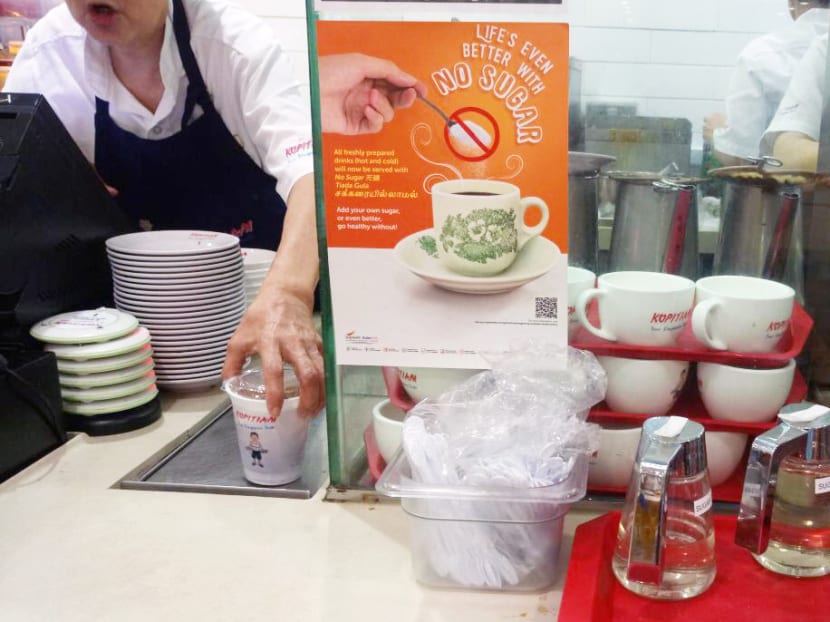No sugar with your kopi? Sugar-free brews coming soon to hospitals, community centres, libraries
SINGAPORE — From May this year, freshly-brewed coffee and tea will be served sugar-free at all government offices, as well as some premises such as parks, sports facilities, and community centres, as the Republic ramps up its nationwide war against diabetes.

Singapore General Hospital’s Kopitiam food court is among the first to support the sugar-free policy. Photo: Kelly Ng/TODAY
SINGAPORE — From May this year, freshly-brewed coffee and tea will be served sugar-free at all government offices, as well as some premises such as parks, sports facilities, and community centres, as the Republic ramps up its nationwide war against diabetes.
Studies have shown that providing sugar as an option, rather than automatically including them in beverages, is effective in cutting down one’s sugar intake.
Under this healthier drinks policy announced by the Health Ministry (MOH) on Wednesday (March 7), beverages from vending machines, food and beverage outlets, and retail stores at these premises must also meet lower in sugar guidelines advocated by the Healthier Choice Symbol.
Singapore General Hospital’s Kopitiam food court and Bengawan Solo outlet are among the first to support the sugar-free policy. Posters have been put up at these outlets advising consumers to “add (their) own sugar, or even better, go healthy without”.
This policy will apply to government offices, public service areas, government premises which promote health and wellbeing — such as parks, sport facilities, community centres — and educational institutions like polytechnics and Institutes of Technical Education, said the MOH, which shared the announcement in conjunction with the ministry’s Committee of Supply debate.
During the debate, Members of Parliament had asked for an update as the Republic enters the third year in its “war on diabetes”.
Parliamentary Secretary for Health Amrin Amin said that an additional S$15 million will be invested over the next two years to fund an existing project, the Healthier Ingredient Development scheme, aimed at developing healthier ingredients, such as sauces, desserts, and beverages with less sugar.
Fourteen manufacturers and food and beverage establishments, among them Swensen’s and the TungLuk restaurant group, have come on board this scheme since its launch in July.
The initiatives will help the Health Promotion Board (HPB) achieve its goal of cutting Singaporeans’ sugar intake by close to a quarter in the next two years.
The Government is currently in its third year of its “war on diabetes” declared in April 2016, when it rolled out a wide-ranging, multi-year plan to promote good dietary and exercise habits to children, encourage early health screening and better disease management, among other things.
According to a report by the International Diabetes Federation in 2015, Singapore has the second-highest proportion of diabetics among developed nations.
The Health Ministry’s (MOH) data shows that some 430,000 Singaporeans today are pre-diabetic, which predisposes them to Type 2 diabetes, heart disease and stroke.
About 18 per cent of individuals — or 20,880 out of 116,000 — who used the HPB’s online risk assessment tool were found to be at higher risk of having diabetes. They were advised to go for further consultation with general practitioners, and undergo cardiovascular risk screening, but the MOH could not share figures on how many eventually followed up with it.
Launched last September, the diabetes risk assessment tool (letsbeatdiabetes.sg/dra) is available for free online.
As of last month, close to 30,000 Singaporeans have also benefited from the national diabetes screening programme, which is provided free for the pioneer generation, and costs S$2 for lower-income Singaporeans under the Community Health Assistance Scheme, and S$5 for all other Singaporeans.
The MOH will also set up a workgroup to study how to reduce the rate of diabetes-related lower extremity amputations here. About 180 lower limb and toe amputations were performed for every 100,000 adult Singaporeans with diabetes in 2015, three times more than the OECD (Organisation for Economic Co-operation and Development) average.
The workgroup, which will include vascular surgeons, family physicians, endocrinologists and podiatrists, will be formed next month.
It will be tasked to review the organisation and provision of diabetic foot services, as well as make recommendations on national care guidelines, roles and training needs of healthcare professionals providing these services. The group is expected to present its recommendations by the middle of next year.






